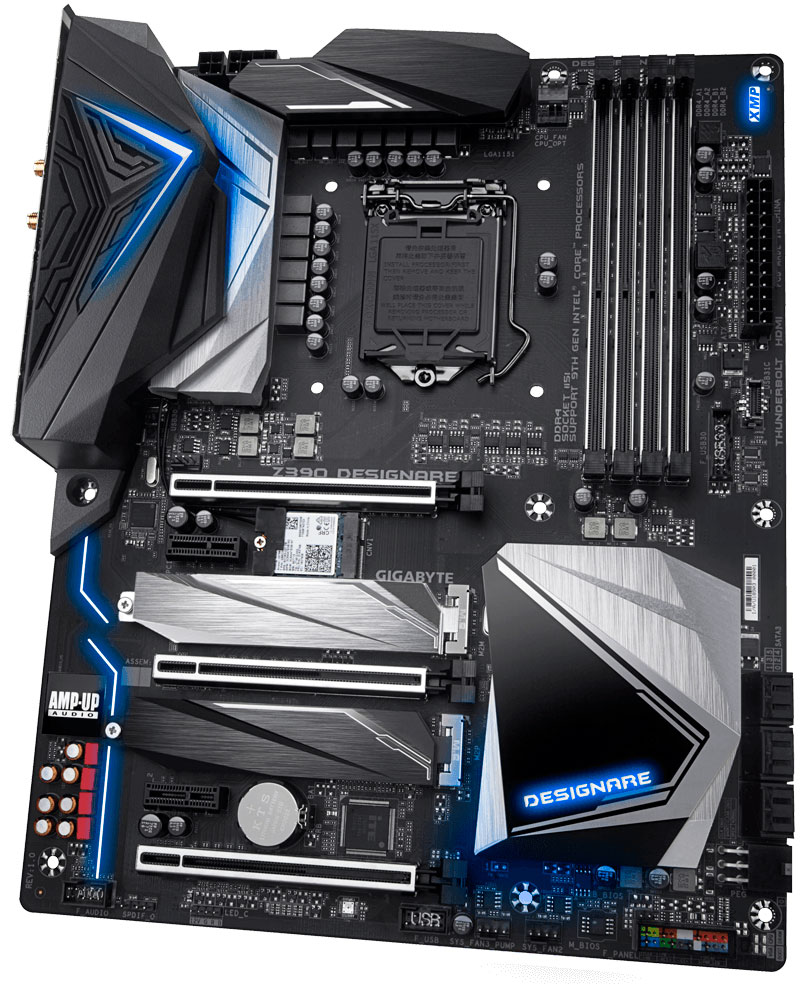Gigabyte Cooks up Z390 Designare Motherboard for Pros
Having launched the majority of its Z390 consumer motherboards a few weeks ago, Gigabyte today brings us the Z390 Designare motherboard that caters to the needs of design professionals and content creators.
Gigabyte markets the Z390 Designare as a feature-packed motherboard that is more than ready to take on Intel's latest Core i9-9900K octa-core processor. The motherboard is built with a 2x copper PCB (printed circuit board) and has been outfitted with a pretty robust 12+1 phase digital power delivery subsystem. Power is supplied to the processor through an 8-pin EPS connector and a secondary 4-pin connector. The motherboard comes with four DDR4 memory slots allowing professionals to cram up to 64GB of memory into their systems. The motherboard is compatible with ECC (error checking and correcting) unbuffered DIMMs and DDR4 speeds up to 4,266MHz and higher.
There are plenty of storage options on the Gigabyte Z390 Designare. Prosumers have access to six SATA III connectors and two M.2 PCIe 3.0 x4 slots, both passively cooled with Gigabyte's M.2 Thermal Guard heat sink to prevent SSD throttling and bottlenecks. The motherboard is Intel Optane-ready and supports popular RAID configurations, such as RAID 0, 1, 5 and 10.
On the expansion side of things, the Gigabyte Z390 Designare has been blessed with three PCIe 3.0 x16 slots reinforced with stainless steel and two PCIe 3.0 x1 slots. Therefore, the motherboard can host up to two Nvidia graphics card in a two-way SLI configuration or three AMD graphics card in a three-way CrossFire configuration. There is also a small M.2 socket 1 connector to house an Intel CNVi wireless module.
Being a motherboard that's tailored around professionals, the Gigabyte Z390 Designare features two high-speed Thunderbolt 3 ports, which opens the door for the use of two 4K displays simultaneously at 60 frames per second or a single 5K display. Additionally, professionals can daisy chain up to 12 Thunderbolt devices of any nature. One of the Gigabyte Z390 Designare's highlights is that it's the first motherboard of its kind to implement a DisplayPort input for an external graphics card. As a result, Nvidia GeForce RTX 20-series owners can connect the graphics card DisplayPort 1.4 output into the motherboard's Thunderbolt.
Connectivity on the Gigabyte Z390 Designare consists of a PS/2 keyboard and mouse combo port, DisplayPort in, HDMI 1.4 port, two USB 3.1 Gen 2 Type-A ports, two Thunderbolt 3 connectors (USB Type-C ports with USB 3.1 Gen 2 support), four USB 3.1 Gen 1 ports and two USB 2.0 ports. The motherboard also sports two Gigabit Ethernet ports and a WiFi 802.11ac Wave 2 and Bluetooth 5 combo. As for audio, it makes use of Realtek's ALC1220-VB codec and comes with five audio jacks and an optical S/PDIF out connector.
Gigabyte hasn't reveal the pricing and availability for the Z390 Designare.
Get Tom's Hardware's best news and in-depth reviews, straight to your inbox.

Zhiye Liu is a news editor, memory reviewer, and SSD tester at Tom’s Hardware. Although he loves everything that’s hardware, he has a soft spot for CPUs, GPUs, and RAM.
-
elbert Great looking motherboard but as a pro I would wait till its validated at the 128GB RAM capacity. Trident Z RGB DC series DDR4 64GB (32GBx2)Reply
-- Intel -- The new 9th Gen Intel Core processors memory controller is capable of supporting DDR4 16Gb die density DIMMs which will allow the processors to support a total system memory capacity of up to 128GB when populating both motherboard memory channels with 2 DIMMs per Channel (2DPC) using these DIMMs. As DDR4 16Gb die density DIMMs have only recently become available, we are now validating them, targeting an update in a few months’ time. -
pawinda I've never really understood Thunderbolt graphics. With Thunderbolt graphics, can I connect the right USB 'C' to display port cable into the Thunderbolt port and use this as my graphics input to my monitor without a stand alone graphics card? If so, is it faster than the HDMI output of the chipset? Thanks.Reply -
Tanyac Finally a Gigabyte board with two Intel LAN ports instead of the Killer LAN garbage. Still not a worthwhile purchase though.Reply
My MSI board has 10 SATA ports, 10 fan headers, 3 M.2 Slots, Dual Intel LAN, Wireless and only cost me $404 brand new.
If this board ever makes it to Australia, and it follows the same trend as other Designare boards it will be $900 - $1000 AUD/$630 - $700 USD -
shadeablaze Might want to double check what the ECC compatibility is. I looked up the 9700k and 9900k, and it looks like both DO NOT support ECC. Saying the motherboard supports it sounds interesting, but how does it support it? What processor would you use?Reply -
MikeODanyurs Newegg.com has this for preorder (due 08 Nov.) for only $270. I can't believe that Gigabyte didn't put a DisplayPort out and the HDMI is only 1.4, if it was 2.0 this would be perfect with the onboard Titan Ridge Thunderbolt 3 for a UHD 4K blu-ray set up. Now it's limited to 4K @ 30Hz instead of 60Hz.Reply -
derekullo Reply21452388 said:Might want to double check what the ECC compatibility is. I looked up the 9700k and 9900k, and it looks like both DO NOT support ECC. Saying the motherboard supports it sounds interesting, but how does it support it? What processor would you use?
In the past the only Intel processors that supported ECC were i3 and Xeons.
Intel won't release an i7 or i9 for that matter with ECC or it would cannibalize Xeon sales.

